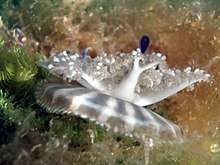Cassiopea
| Cassiopea | |
|---|---|
 | |
| Cassiopea sp. | |
| Scientific classification | |
| Kingdom: | Animalia |
| Phylum: | Cnidaria |
| Class: | Scyphozoa |
| Order: | Rhizostomeae |
| Family: | Cassiopeidae Agassiz, 1862 |
| Genus: | Cassiopea Péron & Lesueur, 1809 |
| Species | |
|
8 species, see text | |
Cassiopea (upside-down jellyfish) is a genus of true jellyfish and the only members of the family Cassiopeidae.[1] They are found in warmer coastal regions around the world, including shallow mangrove swamps, mudflats, canals, and turtle grass flats in Florida, and the Caribbean and Micronesia. The medusa usually lives upside-down on the bottom, which has earned them the common name. Where found, there may be numerous individuals with varying shades of white, blue, green and brown.
Species
According to the World Register of Marine Species, this genus includes 8 species:[2]
- Cassiopea andromeda
- Cassiopea depressa
- Cassiopea frondosa
- Cassiopea medusa
- Cassiopea mertensi
- Cassiopea ndrosia
- Cassiopea ornata
- Cassiopea xamachana
Defence System
Cassiopea species have a mild sting since they are primarily photosynthetic, but sensitive individuals may have a stronger reaction. The photosynthesis occurs because, like most corals, they host zooxanthellae in their tissues.[3] The stinging cells are excreted in a mucus; swimming over the jellyfish (especially using swim fins) may cause transparent, essentially invisible, sheets of this mucus to be lifted up into the water column, where they are then encountered by unsuspecting swimmers. The stings, appearing in the form of a red rash-like skin irritation, are known for being extraordinarily itchy. Sometimes this jellyfish is picked up by the crab Dorippe frascone and carried on its back. The crab uses the jellyfish to defend itself against possible predators.
Behavior
Certain species of Cassiopea have been observed to enter a sleep state, indicated by a decreased pulsation rate.[4]
References
- ↑ WoRMS. "Cassiopeidae". World Register of Marine Species. Retrieved 3 August 2012.
- ↑ WoRMS. "Cassiopea". World Register of Marine Species. Retrieved 3 August 2012.
- ↑ Murphy, Richard C. (2002). Coral Reefs: Cities Under The Sea. Princeton, New Jersey: The Darwin Press. ISBN 978-0-87850-138-0.
- ↑ "The surprising, ancient behavior of jellyfish". EurekAlert. Retrieved 22 September 2017.
External links
| Wikimedia Commons has media related to Cassiopea. |
| Wikispecies has information related to Cassiopea |